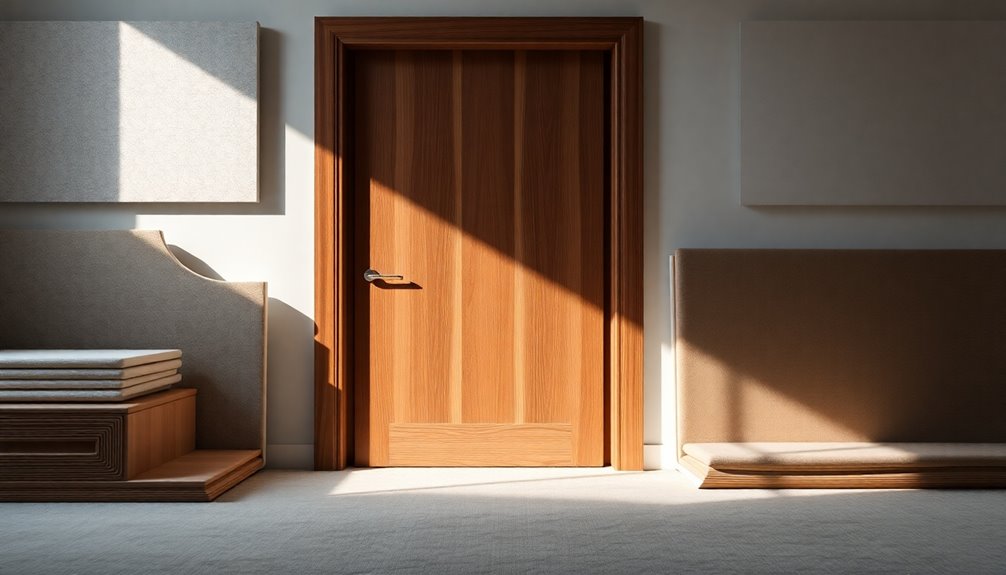If you're looking to soundproof your pocket door on a budget, several low-cost solutions can work wonders. First, consider filling hollow doors with Rockwool insulation for improved dampening. Adding mass loaded vinyl to the door's surface can also block noise effectively. Don't forget to seal any gaps with rubber door sweeps or self-adhesive weather stripping, as they'll help reduce sound intrusion markedly. For temporary measures, attach soundproof blankets using Velcro. Each of these strategies boosts your door's soundproofing while keeping costs low, and exploring further can reveal even more practical tips.
Understanding Pocket Door Limitations
When it comes to soundproofing, pocket doors have notable limitations that can undermine their effectiveness in noise-sensitive spaces.
Typically made from hollow core materials, these doors lack the mass needed to block sound effectively, especially compared to solid core doors. You'll likely notice common gaps at the bottom, which can lead to significant sound leakage, making pocket doors less ideal for areas like home offices where privacy is essential. Additionally, their sound insulation rating often reveals how much noise can still permeate through these structures. To enhance your understanding of soundproofing, consider using budgeting apps to allocate funds for potential upgrades.
Their sound insulation rating, often between 20-30 dB, reveals another drawback; this allows a considerable amount of noise to pass through. For instance, tools like Zoho Expense and FreshBooks can help entrepreneurs manage expenses related to soundproofing improvements, ensuring that investments in a quieter space remain within budget.
Traditional soundproofing methods, like adding mass or insulation, generally fall short due to the structural constraints of pocket doors. Plus, the aesthetic appeal of these doors complicates potential solutions. You want them to look sleek and modern, but that can limit your options for enhancing sound insulation.
For effective expense management apps, incorporating soundproofing solutions can be valuable in maintaining a quiet environment for focused work.
Effective Soundproofing Techniques
Despite the inherent challenges of pocket doors, effective soundproofing techniques can greatly improve their performance in noise-sensitive environments.
Start by adding mass loaded vinyl (MLV) directly to the door's surface; this material effectively blocks sound and can transform your pocket door into a soundproof door. Additionally, utilizing bill tracking tools can help manage expenses related to soundproofing materials. Furthermore, consider exploring automated investment management options to ensure your budget stays on track while investing in home improvements.
Next, don't underestimate the importance of sealing gaps. Implement a door sweep and weather stripping around the edges to minimize sound leakage at the bottom and sides.
If your pocket door is hollow, consider filling it with Rockwool insulation, which provides superior sound dampening compared to cellulose options. This simple upgrade can greatly enhance your door's overall soundproofing capabilities.
For a cost-effective alternative to replacing your pocket doors, soundproof curtains or AcoustiTrac systems can also help reduce noise transmission effectively.
Finally, verify you properly seal all gaps and cracks around the door frame. This meticulous attention to detail can maximize your soundproofing efforts, creating a more peaceful environment. Additionally, utilizing expense categorization tools can help you effectively allocate your budget towards home improvement projects like soundproofing.
Affordable Soundproofing Materials
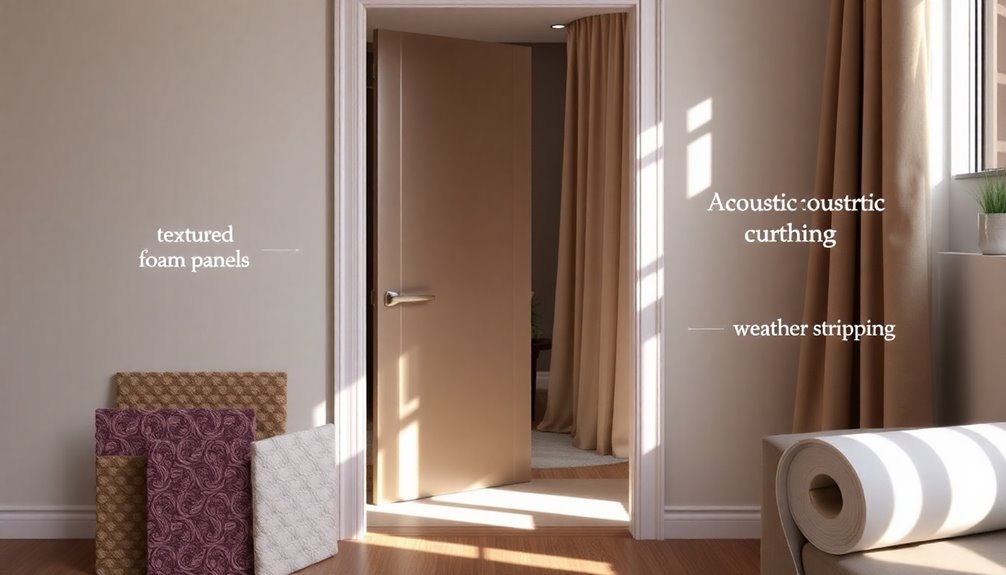
Looking for budget-friendly ways to soundproof your pocket doors? You can achieve impressive results without breaking the bank. One effective material is mass loaded vinyl (MLV). You can easily attach it directly to your pocket doors, considerably reducing sound transmission. Additionally, using a user-friendly interface can help you track expenses related to your soundproofing project.
Moreover, using AI-driven tools can help you discover the best soundproofing materials based on your preferences and budget.
Another low-cost option is rockwool insulation; by filling hollow doors with it, you enhance sound dampening efficiently.
Don't overlook acoustical caulking, which typically costs around $20. Applying it around your door frame and gaps creates a flexible seal that prevents sound from leaking through.
Additionally, consider using heavy-duty moving blankets or sound-absorbing curtains. They're fantastic temporary solutions that block noise while allowing flexibility in your space.
For sealing gaps, inexpensive door sweeps and weather stripping can be added to the bottom and sides of your pocket doors. These simple additions help soundproof a pocket door effectively. Moreover, opting for sustainable packaging materials not only benefits the environment but may also enhance your overall soundproofing efforts by reducing vibrations.
Utilizing Door Sweeps and Seals
How can you effectively reduce sound leakage in your pocket doors? One of the best ways is by utilizing a door sweep or weather stripping. A rubber door sweep can seal the gap at the bottom of your pocket door, considerably minimizing sound transmission when the door is closed. This simple addition creates a barrier that blocks more noise from entering your space. By employing these techniques, you can promote financial awareness as you strategize your budget for home improvement projects.
If you're looking for an easier installation, consider weather stripping. This self-adhesive solution can be applied directly to the door frame, enhancing sound insulation with minimal effort. Investment apps for beginners can also assist you in planning and saving for these types of enhancements.
Regardless of which option you choose, make sure to clean the door bottom before applying either the door sweep or weather stripping. A clean surface improves adhesion and boosts soundproofing effectiveness. Additionally, consider the benefits of using expense tracking apps to manage any costs associated with your soundproofing efforts.
Don't forget the importance of regular inspection and maintenance of your door seals. Over time, wear and tear can reduce their effectiveness, allowing sound to intrude into your home office or quiet spaces.
Sealing Gaps and Cracks
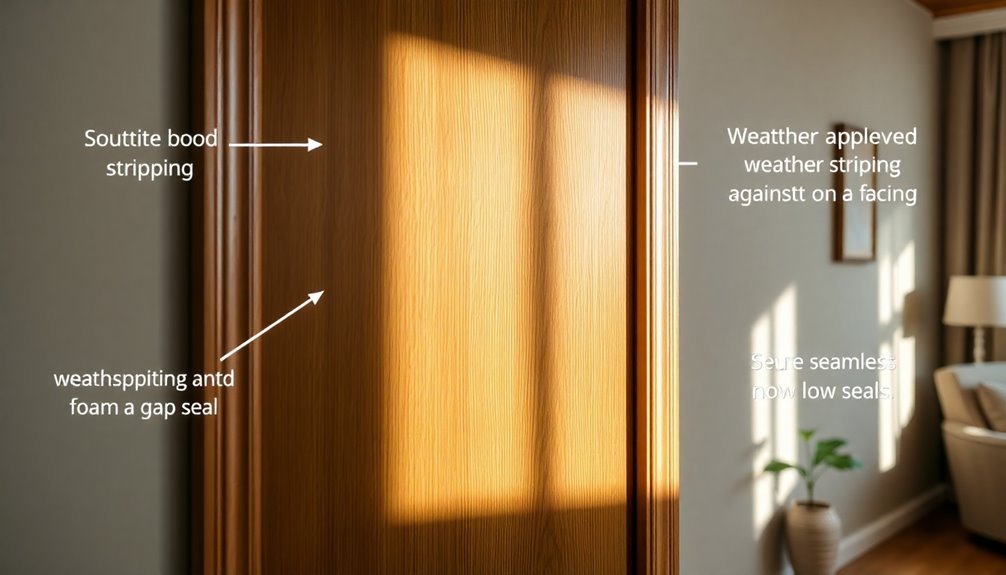
Sealing gaps and cracks around your pocket door is essential for effective soundproofing.
Even tiny openings can let noise slip through, so using the right materials can make a big difference. To maximize your savings, consider joining loyalty programs that can provide exclusive discounts on soundproofing materials. You'll want to contemplate options like rubber door sweeps and acoustical caulking to enhance your door's sound insulation. Additionally, employing loyalty programs optimization can help you find discounts on soundproofing materials to further reduce costs. Offering diverse earning opportunities in loyalty programs can encourage you to engage more with brands that provide the soundproofing materials you need.
Importance of Sealing
When it comes to soundproofing pocket doors, neglecting gaps and cracks can lead to disappointing results. Even small openings can allow considerable noise from entering your space, undermining all your soundproofing efforts. That's why proper sealing is essential.
Start by installing a rubber door sweep at the bottom of your pocket door. This simple addition effectively closes gaps and prevents sound from leaking underneath when the door is closed.
Next, consider applying self-adhesive weather stripping around the door frame. This creates a tighter seal, markedly reducing noise infiltration.
Don't overlook the importance of regular maintenance. Check for loose or cracked areas around the door frame, and apply high-quality acoustical caulking where necessary. This not only improves the overall soundproofing performance but also enhances the longevity of your door's functionality.
Lastly, confirm your door is fully closed and that all seals are intact. This can improve sound isolation by up to 80%, making sealing a critical part of any effective soundproofing strategy.
Effective Sealing Materials
Effective sealing materials play an essential role in enhancing the soundproofing of pocket doors. To effectively minimize sound leakage, you need to seal the gaps and cracks around the door.
Start by installing a rubber door sweep at the bottom of the door. This simple addition fills the gap when the door is closed and markedly reduces sound transmission.
Next, consider using self-adhesive weather stripping along the edges of the pocket door. This creates a tighter seal, which is vital in preventing sound entry.
For the areas around the door frame, acoustical caulking is highly recommended. It remains flexible over time and prevents cracking, guaranteeing a long-lasting barrier against noise.
Before applying any sealing materials, make certain to clean the surfaces thoroughly. This step guarantees better adhesion and maximizes the effectiveness of your soundproofing efforts.
By focusing on these effective sealing materials, you can create a more peaceful environment in your space, making your pocket doors work much harder to keep unwanted noise at bay.
With these simple solutions, you'll enhance your door's soundproof performance without breaking the bank.
Enhancing Windows for Soundproofing
To achieve a quieter living space, addressing your windows is essential. First, check for any loose windows that might be contributing to sound leakage. Confirm they fit snugly within their frames to minimize movement.
If you notice gaps, applying acoustical caulking around the window frames is a must. This flexible seal not only prevents sound from sneaking through but also improves your overall soundproofing efforts. You can find high-quality acoustical caulking for around $20, which helps maintain both sound isolation and aesthetics when matched with your door colors.
Additionally, consider using thicker window films specifically designed for soundproofing. These films can greatly reduce sound transmission while still letting in light.
Pairing them with sound-absorbing curtains can create an effective barrier against noise, especially when combined with other soundproofing measures. This combination not only enhances your sound environment but also adds a decorative touch to your windows.
Temporary Soundproofing Solutions
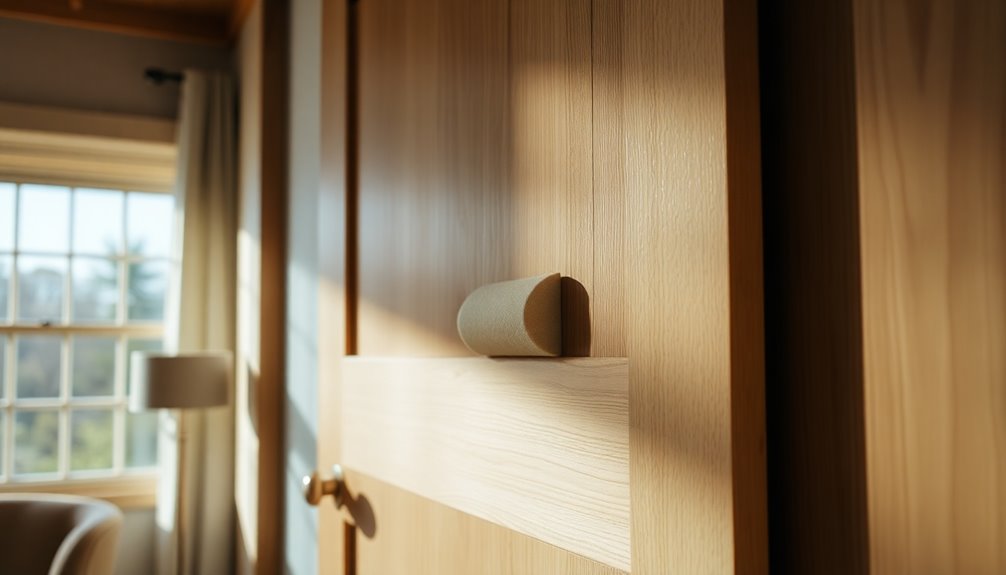
Temporary soundproofing solutions can be a lifesaver when you need quick fixes without committing to permanent changes. One effective method is using Velcro to attach soundproof blankets to your pocket doors. This setup minimizes sound transmission while allowing for easy removal and reattachment, thanks to self-adhesive Velcro strips.
If you're looking for a more impactful approach, consider doubling moving blankets. This technique not only enhances soundproofing effectiveness but also keeps your costs low.
When you're working on temporary solutions, prioritize functionality over aesthetics. After all, your main goal is to reduce sound, and a practical setup will yield better outcomes.
The flexibility of different soundproofing materials, like moving blankets, lets you tailor your approach according to your specific noise reduction needs.
Recommended Soundproofing Products
When looking for reliable soundproofing solutions, it's important to contemplate products designed specifically for this purpose. One of the top recommendations is the AcoustiDoor, which is perfect for nurseries and offices. Priced starting at $119, it hangs neatly over your doorframe and uses mass loaded vinyl to effectively block unwanted noise.
Another great option is the AcoustiTrac, which starts at $139. This product offers easy retractability, making it convenient for daily use while ensuring that outside noise stays out.
If you're interested in something versatile, the AcousticCurtain™ could be your best bet. Starting at $119, it rolls down to create a barrier against sound, and its varying STC ratings allow you to choose the level of soundproofing that fits your needs.
When selecting these soundproof products, remember to check the STC ratings. They provide a clear measure of how well each product reduces sound transmission, helping you make an informed decision.
Investing in these recommended soundproofing products can greatly enhance your comfort and peace in any space.
Community Tips and Insights
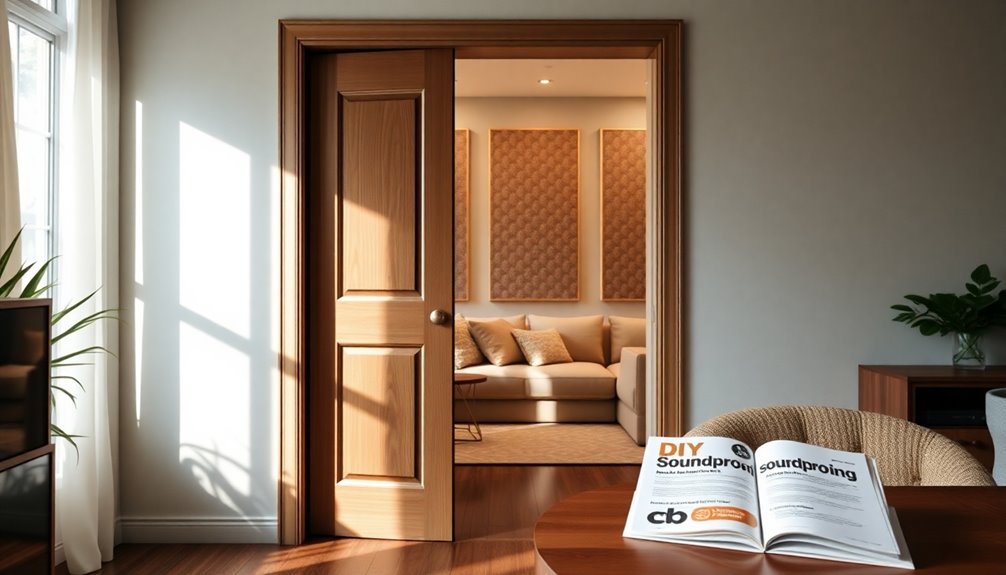
Community members have shared numerous practical tips for enhancing the soundproofing of pocket doors. One popular recommendation is to use mass loaded vinyl (MLV), which is budget-friendly and can be easily attached directly to your door.
Many DIY enthusiasts also emphasize the importance of sealing gaps around pocket doors with weather stripping or door sweeps, as this minimizes sound leakage effectively.
If your pocket door is hollow, consider filling it with rockwool insulation. Community members report noticeable sound dampening improvements when compared to cellulose insulation.
For temporary solutions, heavy-duty moving blankets or sound-absorbing curtains can be applied and removed easily, allowing you to adapt to different situations.
Additionally, placing towels under the doors and caulking around window frames can further reduce noise intrusion.
These small efforts, combined with your pocket door soundproofing strategies, can make a significant difference in your home's overall sound quality.
Long-Term Soundproofing Strategies
For lasting soundproofing success with pocket doors, investing in effective materials and techniques is vital. Start by lining your pocket doors with mass loaded vinyl (MLV). This added mass considerably blocks sound transmission and enhances overall effectiveness.
Next, guarantee you seal any gaps around the door with door sweeps and weather stripping; this prevents sound leakage and improves sound isolation.
Consider installing acoustic dampening boards within the wall cavity where your pocket door slides. These boards can greatly reduce sound penetration while keeping your space aesthetically pleasing.
Filling hollow pocket doors with rockwool insulation also provides superior sound absorption compared to traditional materials, giving you better sound dampening.
Finally, don't overlook the importance of regularly evaluating and improving your sealing materials. Using high-quality acoustical caulking around the door frame will guarantee long-term soundproofing effectiveness.
By implementing these strategies, you can create a quieter environment that stands the test of time, making your pocket doors not only functional but also a barrier against unwanted noise.
Take these steps, and you'll enjoy the peace and tranquility you desire in your home.
Conclusion
To summarize, soundproofing your pocket door doesn't have to break the bank. By using effective techniques and affordable materials, you can greatly reduce noise without feeling like you're building a fortress. Remember, even the best ideas aren't worth a hill of beans if you don't take action. So, roll up your sleeves, implement these solutions, and enjoy a quieter home. You'll soon appreciate the difference a little effort can make in your everyday life!

